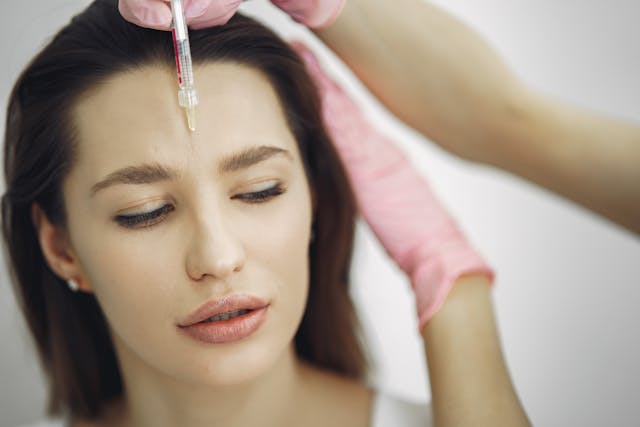Botox, short for Botulinum toxin, is a neurotoxic protein derived from the bacterium Clostridium botulinum. Despite its association with botulism, a severe illness caused by the bacterium, Botox is used in controlled doses for various medical and cosmetic purposes. It was first approved by the FDA in 1989 for medical uses and later gained popularity for its cosmetic applications. Botox works by blocking nerve signals to muscles, temporarily paralyzing them and reducing wrinkles and fine lines.
Mechanism of Action
The mechanism of Botox involves blocking the release of acetylcholine, a neurotransmitter responsible for muscle contractions. By interfering with this process, Botox prevents the targeted muscles from contracting, leading to a temporary relaxation of the muscles. This results in the smoothing of wrinkles and fine lines, particularly those caused by repetitive facial movements such as smiling, frowning, or squinting.
Cosmetic Applications
Botox is primarily used for cosmetic purposes to enhance facial appearance and reduce the signs of aging. It is commonly employed to diminish the appearance of wrinkles and lines on the forehead, around the eyes (crow’s feet), and between the eyebrows (frown lines). Additionally, Botox can be used to lift sagging eyebrows, soften neck bands, and create a more defined jawline. Its precise and targeted action makes it a popular choice for achieving a rejuvenated and youthful look without the need for invasive surgery.
Medical Uses
In addition to its cosmetic applications, Botox is utilized in various medical treatments. One of its most well-known medical uses is in the treatment of chronic migraines, where it is injected into specific sites on the head and neck to reduce headache frequency and severity. Botox is also effective in treating hyperhidrosis (excessive sweating) by blocking the nerve signals that stimulate sweat glands, resulting in drier underarms, palms, or soles of the feet. Other medical conditions treated with Botox include overactive bladder, muscle spasms, and certain eye disorders like strabismus (crossed eyes) and blepharospasm (eyelid spasms).
Procedure Overview
The procedure for administering Botox typically begins with a consultation with a qualified healthcare provider. During this consultation, the provider will assess the patient’s concerns, medical history, and aesthetic goals to determine if Botox is suitable for them. Once approved, the actual injection process is relatively quick and straightforward, often taking less than 15 minutes to complete. The provider will use a fine needle to inject small amounts of Botox into specific muscles, targeting areas of concern such as forehead lines, crow’s feet, or frown lines. While some discomfort may be experienced during the injections, it is generally well-tolerated by most patients. To minimize any pain or discomfort, the provider may apply a topical numbing cream or use ice packs before the procedure.
Risks and Considerations
While Botox is considered safe when administered by a qualified healthcare professional, it is not without risks. Common side effects of Botox injections include temporary bruising, swelling, or redness at the injection site. Some patients may also experience headaches or mild flu-like symptoms following treatment, though these typically resolve within a few days. In rare cases, more serious side effects such as muscle weakness, drooping eyelids, or difficulty swallowing or breathing may occur, especially if the toxin spreads beyond the intended injection site. It is crucial to discuss any concerns or medical conditions with your provider before undergoing Botox treatment to ensure a safe and satisfactory outcome.
Choosing a Provider
Whether you’re contemplating Botox in Asheville, NC, or elsewhere, choosing the right provider is paramount for a successful treatment. When choosing a provider, it is important to consider factors such as their credentials, reputation, and communication style. Look for a provider who is a licensed healthcare professional with training and experience in administering Botox injections. You can research their credentials and read reviews or testimonials from previous patients to gauge their reputation and level of expertise. Additionally, choose a provider who listens to your concerns, answers your questions, and discusses realistic expectations for the outcome of the treatment. A good provider will work with you to develop a personalized treatment plan that addresses your specific needs and goals, ensuring a positive experience and satisfactory results.
Cost
The cost of Botox treatment can vary depending on factors such as the provider’s expertise, geographic location, and the number of units required for the desired results. On average, Botox injections can range from a few hundred to several hundred dollars per treatment area. Since Botox is considered a cosmetic procedure, it is typically not covered by insurance. However, some providers may offer financing options or package deals to make treatment more affordable for patients. It is important to discuss the cost of treatment with your provider during the initial consultation and inquire about any available payment plans or discounts that may apply.
- MORE READ:
Conclusion
Botox is a versatile treatment that offers both cosmetic enhancement and medical benefits. Understanding how Botox works, its various applications and the procedure involved can help you make an informed decision about whether it is right for you. By choosing a qualified provider and discussing any concerns or medical conditions beforehand, you can undergo Botox treatment safely and effectively, achieving the desired results and enhancing your overall quality of life.




